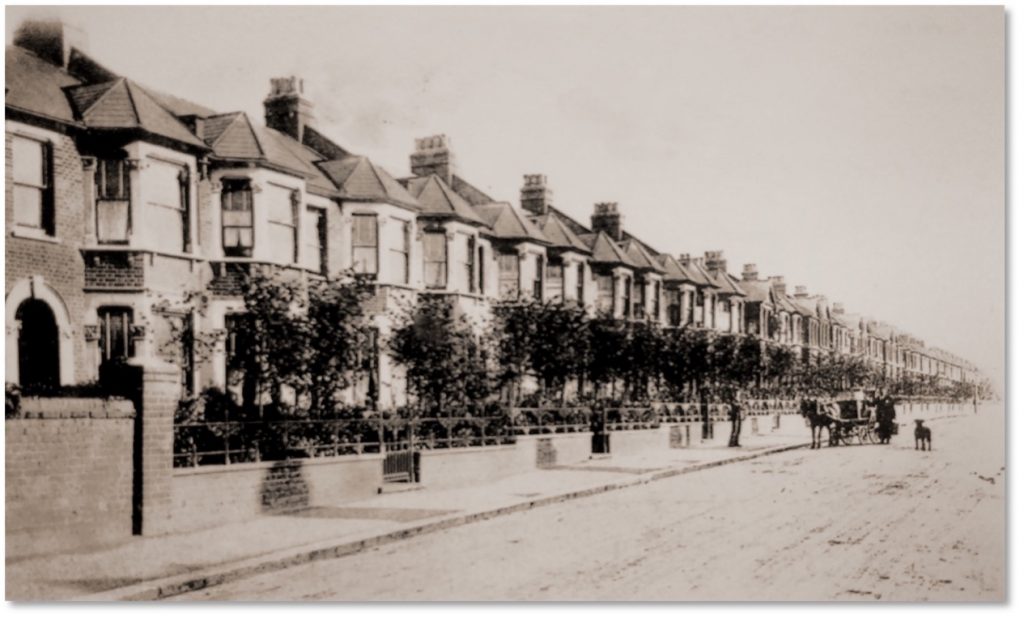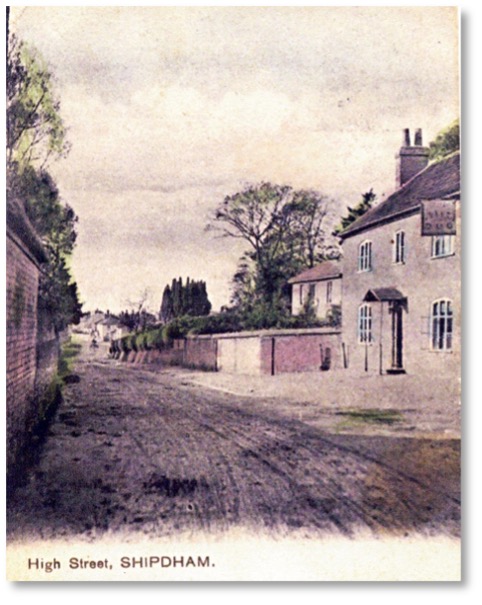“Home of the Estate’s oldest resident”

Broadfield Road c1910, probably from near the junction with Brownhill Road
Background
Broadfield Road lies in the eastern side of the Corbett Estate, and runs precisely north-south for over half a mile from Brownhill Road to Hazelbank.
Building stated in 1901, so the street can claim to have some of the very first Edwardian houses in the country, after Queen Victoria died in January and her son took over to rule as King Edward VII.
The Early Residents: details from the 1911 Census
By the time of the census in 1911, the road was long-since completed, and the 168 houses listed were home to 756 people (plus 11 visitors that day). There’s a mixture of four-bed double-fronted houses and single-bay three-bedders.
55% of the residents were female, and 45% male, which isn’t too far off the Estate averages of 53% and 47%. There was an average of 4.5 people living in each house; and 2.3 children per family (excluding those without any children). 83% of households contained a married couple, which sounds a lot but is actually lower than the Estate average of 89% (to put that into context, in 2019 the comparable figure was 66%).
The most common surname was Smith, which was also the case across the Estate generally, and the road was home to a huge number of Mary and Williams (which also happened to be the most popular adult names). Several were actually married to each other: there was Mary and William Lovegrove at No. 178; Mary and William Venner at No. 109; and to cap it all, the William and Marys at Nos.180 and 185 also had the same surname of Cherry. Pity the poor postman!
Children’s Names
The children of Broadfield didn’t follow the William and Mary trend. The top girls’ names were Dorothy, Kathleen and Winifred; whilst the boys were most liklely to be called Harold, Arthur or John. However, even though there weren’t many little Mary and Williams running around, a large number of children were named after one parent or the other. 66 families in the street named a son or daughter after the father or mother – usually the eldest child.
Most populous house
Whilst the very well-to-do of Broadfield had a live-in servant (there were 33 such servants on the road in total, but of course many more would have arrived during the day to do household chores), one family that didn’t but could probably have done with one were the Smiths at No. 104. 33-year-old Annie was married to Frederick, and she’d had a daughter, Winifred, at the age of 22. Two years later she’d had a son, also called Frederick, and every year thereafter she’d had another son, except when she turned 28. That’s eight sons, together with daughter Winifred. And who’s to say she didn’t have son number nine later in 1911?!
A Billiard Player and a Single Lady
One of the women who stands out is Eleise Sachse, who had been born in Hong Kong, and qualifies as the resident from furthest afield. It’s not only the fact that she was born a long way from Catford that makes her interesting however: she was a rare female Head of Household who was also single. There were 261 female Heads listed, but over 60% were widows, and most of the rest were married so we can assume their husband might have been away on the day of the census. 26-year-old Eleise however was unmarried, and listed no job: she had ‘Private Means’ to run her large 4-bed house at No. 92.
And finally… one person on the street who stands out for the job they did is Arthur Bundey at No. 51. Not for him the tedium of the clerk’s life, like so many on the Estate: he lived a rather more glamorous lifestyle as a ‘Professional Billiards Player’. He was 49, married to Frances, and they had three young sons. Hopefully Arthur’s ability with the cue meant they could all be clothed and fed…
The Oldest Resident
Not far from the Smiths, at No. 72, lived a lady called Sophia Rose, who was notable for being the oldest resident – not just on Broadfield, but on the whole of the Corbett Estate. She was born Sophia Vardon, in Shipdham, Norfolk, in late 1816 or January 1817. That’s just a year or so after the Battle of Waterloo, in the reign of George III. She would have been 94 years of age.

Shipdham in Norfolk
Sophia had married William Rose, a Norfolk Draper, in 1839, and between 1841 and 1860 they had seven children: Ella, William, Thomas, Clara, Laura, Florence and Ida. Sadly, over the following decade, six of the children had died, and only Florence survived. She went on to marry and have four children of her own before becoming widowed.
Sophia’s husband William had joined the police in the 1840s and risen to the rank of Superintendent, but he too had died aged 57 in 1874.
In 1908, Sophia, Florence and the four children all moved into the Corbett Estate, but Sophia died not long after the census was taken in 1911.
Wartime in Broadfield
The First World Wartouched many streets on the Corbett Estate, with young men going off to fight and young women becoming nurses and finding other ways to support the war effort.
One such young soldier was Herbert Donaldson, who lived with his parents Robert and Lena at No. 61, together with his two brothers and sister Beatrice. He enlisted in the 20th Battalion (Blackheath and Woolwich) London Regiment on the 7th September 1914, along with brother Leonard. They were 21 and 23 respectively and, like their elder brother Robert, worked as clerks before the outbreak of war.

Second Lieutenant Herbert Graham Donaldson
Herbert arrived in France on 9th March 1915, and took part in the battles of Loos and the Somme. He progressed through the ranks and was commissioned in April 1917. He then joined the Royal Flying Corps as an observer.
On 12th February 1918 the aircraft in which he was flying crashed on take-off at Tydd St Mary in Lincolnshire. The crash apparently only stunned him, but the plane’s fuel caught fire and he was badly burned. The pilot received some injuries trying to rescue him.
Lieutenant Donaldson was taken to hospital in Cambridge where he died from his injuries aged 25. He’s buried in Brockley cemetary.
The Second World War also left its mark not only on the inhabitants of Broadfield, but on their houses too. It was one of the most heavily-bombed streets on the Estate, with only the properties in the southern end near Hazelbank Road escaping any damage at all. The worst attack was when a German V1 rocket hit the northen end (roughly Nos 27 – 41) and completely destroyed several houses. Others nearby had to be demolished, and around 15 completely rebuilt after the war ended.